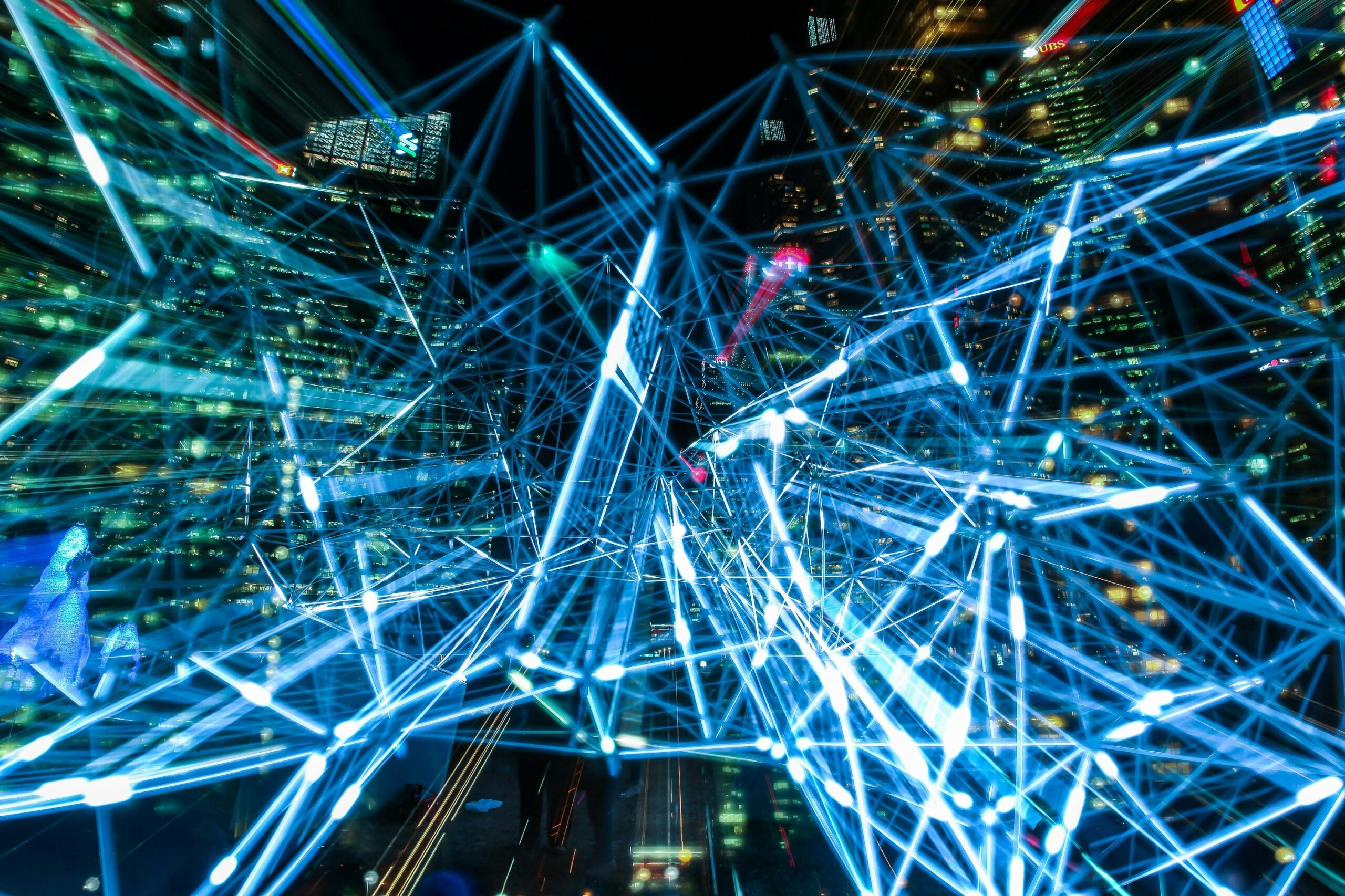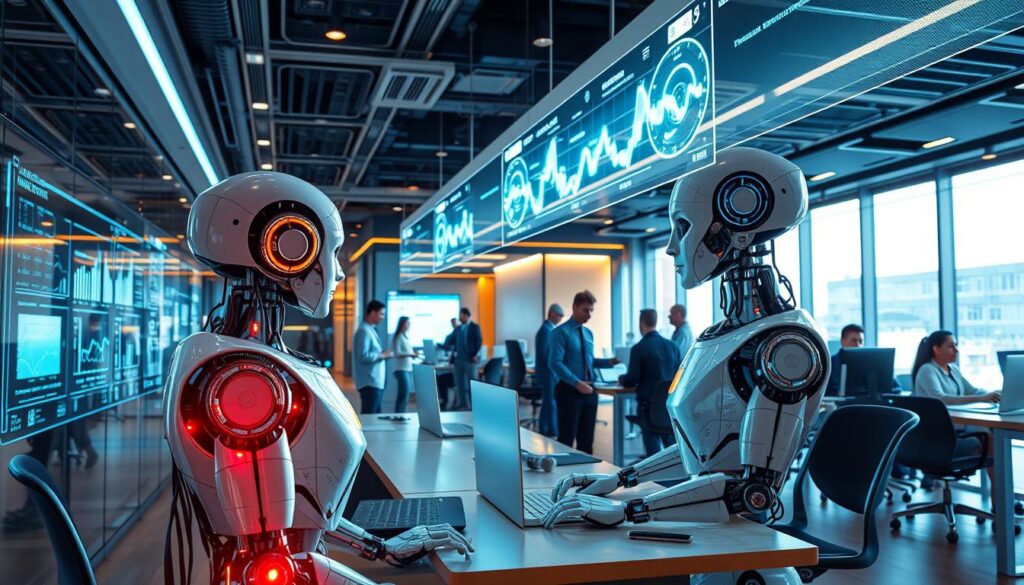Physical Address
304 North Cardinal St.
Dorchester Center, MA 02124
Physical Address
304 North Cardinal St.
Dorchester Center, MA 02124

Artificial intelligence, or ai, is changing the world fast. It’s making big changes in industries and our daily lives. It’s key to know how ai works and what it can do.

Ai is growing in many areas, showing its huge value. We’ll look at ai’s current role, its future, and how it’s changing our lives. Knowing about ai helps us enjoy its new ideas.
Artificial intelligence has grown a lot since it started. It has moved from simple machines to smart systems that can learn and change. At the core of this change is machine learning. This part of AI lets systems get better with time by learning from data.
Exploring AI, we find key parts that make it work. These are algorithms, data, and computing power. Together, they help neural networks handle and understand lots of information.
The journey of AI technology has seen big steps forward. It started with the first AI program in 1956 and now we have deep learning and neural networks. This progress is thanks to better computers, more storage, and new ways to work with data. It has led to more advanced AI systems.
So, what makes up AI systems? The main parts are:
There are different kinds of artificial intelligence. These include narrow or weak AI, general or strong AI, and superintelligence. Each type has its own features and uses, from virtual assistants to self-driving cars.
As we keep exploring AI, it’s key to understand machine learning and neural networks. They are crucial in shaping AI. By grasping these, we can unlock AI’s full potential. This will help us create a future where humans and machines work together to achieve amazing things.
Machine learning is key to AI, letting systems learn from data on their own. It uses supervised, unsupervised, and reinforcement learning to do this. Deep learning, a big part of machine learning, uses neural networks to understand data.
Some examples of machine learning in action include:
These uses are pushing AI forward, with deep learning leading the charge.
As machine learning grows, we’ll see more cool uses of deep learning. It’s great at handling complex data and learning from it. So, deep learning will be key in shaping AI’s future.
| Machine Learning Technique | Description |
|---|---|
| Supervised Learning | Learning from labeled data |
| Unsupervised Learning | Learning from unlabeled data |
| Reinforcement Learning | Learning through trial and error |
Deep learning is a part of machine learning that uses neural networks. These systems are like the human brain, learning and adapting. They’re great at tasks like recognizing images and speech, natural language processing, and robotics.
Deep learning gets better with more data. This is key for self-driving cars, which need to adapt to new situations.
Neural networks have layers of nodes or “neurons.” Each layer looks at different parts of the data. This lets the network understand complex information.
Deep learning has many uses:
These uses could change many industries. From healthcare to education, deep learning has a big impact.
Natural Language Processing (NLP) is a field of AI that helps computers understand and talk like humans. It lets computers do things like translate languages, summarize texts, and figure out how people feel. This makes computers more useful in our daily lives.
One big use of NLP is in language translation. It lets people who don’t speak the same language talk to each other. This works great with computer vision, which can analyze images and videos. For instance, you can use a smartphone app to translate signs or menus in other languages.
Some examples of NLP applications include:
NLP is changing how we talk to computers and each other. Its uses are endless and getting more exciting. As NLP keeps getting better, we’ll see even more cool ways it works with computer vision.
| NLP Application | Description |
|---|---|
| Language Translation | Enables people who speak different languages to communicate with each other |
| Text Summarization | Automatically summarizes long pieces of text into shorter, more digestible versions |
| Sentiment Analysis | Analyzes text to determine the sentiment or emotional tone behind it |
Computer vision is a field of ai that lets computers understand visual information. It has many uses, like recognizing images, detecting objects, and understanding scenes. Automation makes these uses more efficient and accurate.
Image recognition is key in computer vision. It uses ai to spot and sort objects in images. For instance, self-driving cars use it to see pedestrians, traffic lights, and other cars.
Video analysis is also vital in computer vision. It lets computers study and grasp video footage, tracking objects and spotting patterns. This tech is used in surveillance and medical imaging.
These examples show how powerful computer vision is. It has the potential to change many industries. As ai and automation get better, we’ll see even more cool uses of computer vision.
Artificial intelligence is changing how businesses work. It makes customer service better with chatbots and improves supply chains with predictive analytics. Machine learning helps drive innovation and efficiency in healthcare, finance, and manufacturing.
Here are some examples of AI success:
As AI gets better, we’ll see more cool uses of machine learning and deep learning in business. This could lead to big gains in efficiency and revenue. That’s why companies are putting a lot of money into AI research.

AI is not just a tool, but a strategic partner that can help businesses achieve their goals and stay ahead of the competition.
By using AI, businesses can find new ways to grow and innovate. This helps them stay competitive in a fast-changing world.
| Industry | AI Application | Benefits |
|---|---|---|
| Healthcare | Predictive analytics | Improved patient outcomes, reduced costs |
| Finance | Automated trading | Increased efficiency, reduced risk |
| Manufacturing | Predictive maintenance | Reduced downtime, increased productivity |
Artificial intelligence is advancing fast, but it raises big questions about ethics and social impact. The use of neural networks and natural language processing worries people about privacy, job loss, and unfair decisions.
Some major issues with AI ethics include:
To tackle these issues, we need to create ethical guidelines for AI. We should focus on making AI systems transparent, accountable, and fair. This means testing AI well and designing it with human values in mind.
By focusing on ethics and social responsibility in AI, we can use neural networks and natural language processing for good. This way, we can build a fairer and more just society.
| AI Technology | Ethical Considerations |
|---|---|
| Neural Networks | Privacy, bias, and transparency |
| Natural Language Processing | Accuracy, fairness, and accountability |
AI technology is growing fast, but it faces many challenges. One big issue is that current AI systems lack common sense and know-how. For example, robotics and computer vision can help make AI more accurate. Yet, they are not used much yet.
Some major hurdles in AI development include:

computer vision and robotics, developers aim to make AI smarter. This way, AI can better understand and interact with its surroundings.
Overcoming these challenges is key to AI’s future. By knowing what holds AI back, we can make it more useful and efficient. This will help AI be used in many different ways.
Looking ahead, artificial intelligence will play a big role in our world. It has the power to tackle big challenges like climate change and sustainable development. AI is growing fast and getting better, thanks to its connection with other tech like the Internet of Things (IoT).
Some exciting uses of AI in the future include:
As AI keeps getting better, we’ll see big changes in automation and more. It has the chance to change many industries and our daily lives. The future of artificial intelligence looks very promising.
“The future of AI is not just about machines, it’s about the potential for humans and machines to work together to solve some of the world’s most complex problems.”
| Potential Application | Description |
|---|---|
| Healthcare | AI-powered diagnosis and treatment options |
| Transportation | Self-driving cars and smart traffic management |
| Education | Personalized learning plans and AI-powered adaptive assessments |
AI technology is set to change many parts of our lives and work. It will make communication better with natural language processing and help us make smarter decisions with machine learning. The future of AI is bright, full of chances for growth and making a positive difference.
It’s time to start embracing this AI-driven future. By learning about AI, we can use its power to change things for the better. Whether you’re working on AI projects, finding new uses for it, or just keeping up with the news, you can help shape its future.
As we go forward, let’s be curious, innovative, and ethical with AI. This way, we can enjoy its benefits and avoid its downsides. With AI, the future is wide open, full of endless possibilities.
Artificial intelligence (AI) is about making computers do things that humans do. This includes learning, solving problems, making decisions, and seeing things.
An AI system has three main parts: algorithms, data, and computing power. Algorithms are the rules that help the system learn and decide. Data is what the algorithms use to find patterns and make predictions. Computing power lets the system handle lots of data quickly.
There are a few types of AI. Narrow AI does one thing well. General AI can do many things. Superintelligence is even smarter than humans.
Machine learning lets systems get better over time without being programmed. It uses algorithms to look at data, find patterns, and make choices. There are different ways to learn, like supervised, unsupervised, and reinforcement learning.
Deep learning uses artificial neural networks to understand complex data like images and speech. It doesn’t need human-made features, unlike traditional machine learning.
NLP helps computers understand and create human language. It’s used for things like translating languages, summarizing text, and making chatbots.
Computer vision and pattern recognition are used in many ways. They help with image analysis, object detection, facial recognition, and even in self-driving cars. These technologies let computers understand and interpret visual information.
AI is changing many industries. It improves customer service, optimizes supply chains, automates tasks, and drives innovation. Businesses use AI to analyze data, make predictions, and automate decisions, leading to better efficiency and cost savings.
AI raises concerns about privacy, data usage, job loss, and bias. Ethical guidelines are being made to ensure AI is developed and used responsibly. This includes focusing on transparency, accountability, and fairness.
AI development faces technical challenges like lack of common sense and vulnerability to attacks. It also needs a lot of resources for training and deployment. There are also hurdles in integrating AI with existing systems and addressing ethical concerns.
AI’s future is very promising. It could change many industries and solve big challenges. Advances in automation, integration with other technologies, and ethical AI can lead to new innovations and solutions in areas like healthcare and climate change.